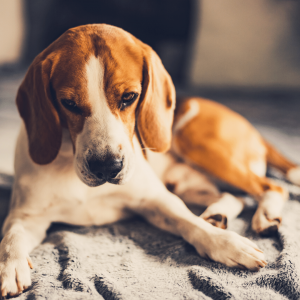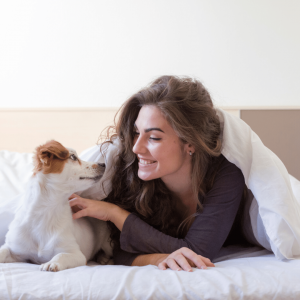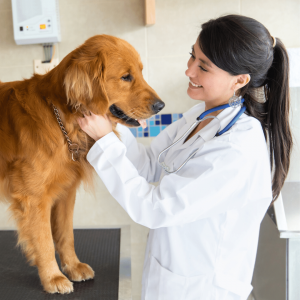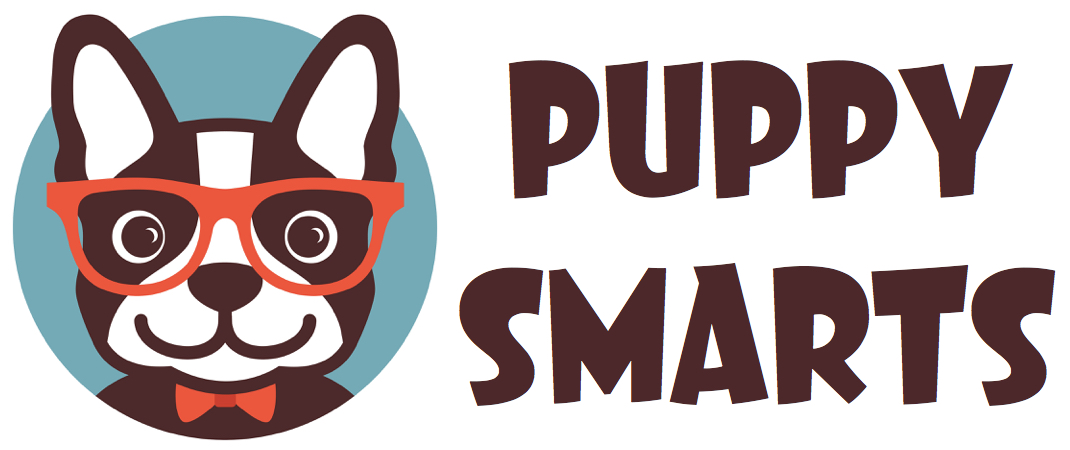How Do You Cheer Up a Dog Who’s Depressed?

Contents
Is your doggy sleeping a lot, acting kind of mopey, and eating less than usual? Sounds like you might have a depressed dog on your hands! Any time your best friend’s behavior seems a little off, it’s normal to be worried. It turns out that dogs can feel a little down in the dumps sometimes, much like their human family members. But, how do you cheer up a dog who’s depressed? Does he just need a good cuddle, or is it time to see the vet?
What Every Dog Owner Should Know About Canine Depression
Did you know that your furry friend can actually read your emotions? According to studies, dogs can tell if you’re happy, sad, or angry by your facial expressions! Our furry family members are extremely sensitive, and they often communicate with us pretty clearly, if you know how to listen.
Most pet owners will agree that dogs show their emotions in a variety of ways, from tail wagging and jumping around when we get home, to head hanging when they’ve done something wrong, and puppy eyes when they’re hoping for a treat. It’s usually pretty easy to tell when their scared, too.
Many times, the symptoms of depression in dogs are very similar to those in humans. They seem withdrawn and uninterested in what’s going on around them. Your normally food-oriented pooch might even lose interest in dog food or special treats.
In some cases, canine depression is caused by boredom or separation anxiety. Other times, the dog’s behavior changes after a major life event, such as moving to a new home, the loss of a companion pet or family member, or even the addition of a new baby or a new puppy who’s competing for the attention.

Telltale Signs of a Depressed Dog
Dogs display sadness in a variety of ways, but it can be easy to miss if you don’t know what you’re looking for. The most common symptoms of depression to look for include:
- Listlessness or lethargy: If there’s one trait pretty much every dog has in common, it’s an enthusiasm for life. They are generally joyful creatures, which is why we love being around them so much. If your normally enthusiastic dog suddenly begins to act withdrawn, listless, or lethargic, he may be depressed or not feeling well.
- Clinginess or dependency: A dog who’s feeling depressed will often become very clingy to someone in the family, or he might suddenly be dependant on a certain toy.
- Reluctance to go outside: Going for a walk is usually the highlight of a dog’s life. If you’re dog suddenly doesn’t want to go outside, he could be depressed or experiencing health problems.
- Changes in sleeping habits: Much like humans, a sad dog will probably sleep a lot more than usual. He may simply lay around the house, sleeping through everything that’s going on around him.
- Changes in appetite: Most dogs are happy to wolf down their dog food and then beg for your dinner as well. If your dog isn’t eating as much as he normally does, or refuses to eat at all, he may be experiencing depression or not feeling well.

How Do You Cheer Up a Dog Who’s Depressed?
When your best friend is feeling down, it can be tough on you as well. Dog owners rely on their furry friends to cheer them up, so now it’s your turn to do the same for him!
Here are 10 things you can do to cheer up a dog who’s depressed:
1. Start by spending some extra time with your pooch.
Sometimes, dogs become depressed when they’re lonely or bored, so spending a little extra time with him can do wonders. Some cuddles, a long walk, a trip to the dog park, or a game of fetch might be all your dog needs to bring him out of his funk. When you can, keep him with you as you go about your day so he doesn’t feel alone or slip back into his depressive state.
2. Socialization might help.
If your dog has recently lost a beloved companion, animal or human, providing ways for him to socialize with other dogs might be very helpful. Dogs are pack animals and they enjoy interacting with their own species, so try doggie daycare or head to the dog park where he can make some new furry friends.
3. Keep him active.
Staying active is crucial for humans with depression, and it’s no different for dogs. He may not be into playtime at first, but a long walk through the neighborhood or the park is a great way to snap him out of his depression. The physical exercise, sunshine, fresh air, new environment, and extra time with you is great for his mental outlook, no matter what activity you choose. You could head to the water for a swim, go in the backyard for a game of fetch, or hit a local hiking trail. You’ll both come back from these fun activities feeling happier than you did before!
4. Pay attention to your own moods.
Remember what we said in the beginning about dogs being able to sense your emotions? Paying attention to your own moods is crucial, especially when you’re around your dog. If you’re cheerful and happy, your dog will feel that joy and it will rub off on him. Unfortunately, if your family is arguing or sad, those negative emotions will affect him, too.
5. Try some positive reinforcement.
Animal behaviorists also recommend positive reinforcement to help a sad dog snap out of his bad mood. Anytime your dog starts to act more like his normal, happy self, break out his favorite dog treats and give him lots of pets and love. Showing him how happy you are to see him happy will reinforce the positive behavior.
6. Bring out his favorite dog toys.
If your dog is feeling bummed out about a recent move or change in the family dynamics, his favorite toys can be very comforting. Dogs love routine and familiarity so be sure to keep his favorite things around him.
7. Or, buy him so new ones.
Staying busy is key for snapping out of a bad mood, so pick up some new toys for your doggy if he’s feeling down. Interactive puzzle toys are a great choice because they provide some much needed mental stimulation. Chew toys, squeaky toys, and balls are all great, too, if that’s what your pooch is in to.

Final Thoughts: Does Your Depressed Dog Need to See the Vet?
Do you need to take your dog to the vet if he seems depressed? It depends. If he’s displaying symptoms of illness, such as a refusal to eat, diarrhea, vomiting, or fever, head to the vet right away. If he seems to be in pain, a trip to the vet is definitely in order, as well.
Keep in mind that many medications have side effects that can be similar to the symptoms of depression. Any time your dog starts a new medication, ask lots of questions, and do your own research so you know what to expect. If your dog’s reaction seems unusual, call the vet immediately.
Older dogs will often slow down and sleep more as they age, which can be perfectly normal. However, if your older dog seems confused or is showing other signs of dementia, there are lots of things you can do to help at home, and your vet may be able to offer additional advice. A visit to the vet will confirm the diagnosis and rule out other medical conditions.
If you try the above tips for a few days and your dog doesn’t seem to be improving, a trip to the vet is required to rule out any health problems. In fact, if you are at all concerned about your dog’s health and behavior, a trip to the vet is a good idea, even if it’s just for your own peace of mind.
